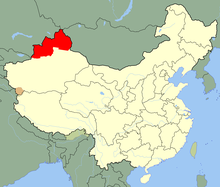
Back تمرد إيلي Arabic Drei-Bezirke-Revolution German Rebelión Ilí Spanish شورش ایلی Persian Rébellion Ili French Pemberontakan Ili ID Ribellione di Ili Italian Drie Districten-opstand Dutch Rebelião de Ili Portuguese Илийское восстание Russian
| Ili Rebellion East Turkestan National Revolution Three Districts Revolution | |||||||
|---|---|---|---|---|---|---|---|
 | |||||||
| |||||||
| Belligerents | |||||||
|
|
Supported by: | ||||||
| Commanders and leaders | |||||||
| |||||||
| Units involved | |||||||
| |||||||
| Casualties and losses | |||||||
| Total casualties unknown, many Chinese civilians killed in Ili alongside a number of Chinese soldiers | Total casualties unknown, heavy losses among Russian settlers fighting for the Second East Turkestan Republic, many civilian and military losses taken | ||||||
The Ili Rebellion (simplified Chinese: 伊宁事变; traditional Chinese: 伊寧事變; pinyin: Yīníng Shìbiàn[3]) was a separatist uprising by the Turkic peoples of northern Xinjiang (East Turkestan) against the Kuomintang government of the Republic of China, from 1944 to 1946. The Ili Rebellion began with the East Turkestan National Revolution, known in Chinese historiography as the Three Districts Revolution (simplified Chinese: 三区革命; traditional Chinese: 三區革命; pinyin: Sān-qū Gémìng; Uyghur: ئۈچ ۋىلايەت ئىنقىلابى), which saw the establishment of the Second East Turkestan Republic. The leadership was dominated by Uyghurs but the population consisted mostly of Kazakhs.[4]
- ^ Forbes (1986)
- ^ Forbes (1986), p. 215
- ^ Ildikó Bellér-Hann (2007). Situating the Uyghurs Between China and Central Asia. Ashgate Publishing, Ltd. pp. 109–. ISBN 978-0-7546-7041-4.
- ^ Wang 2020, p. 265.
© MMXXIII Rich X Search. We shall prevail. All rights reserved. Rich X Search